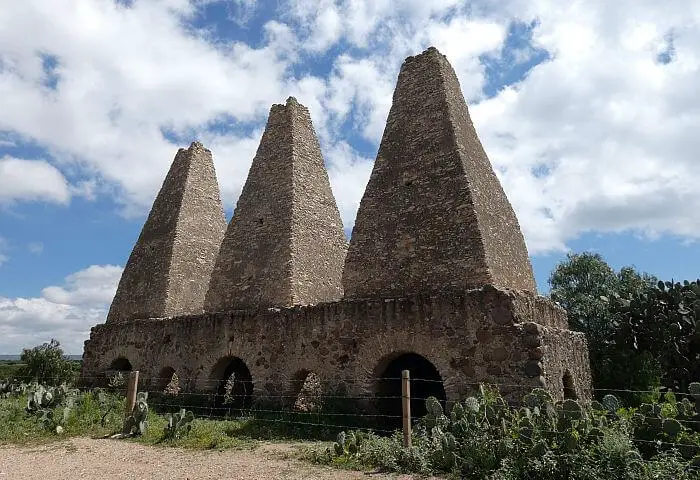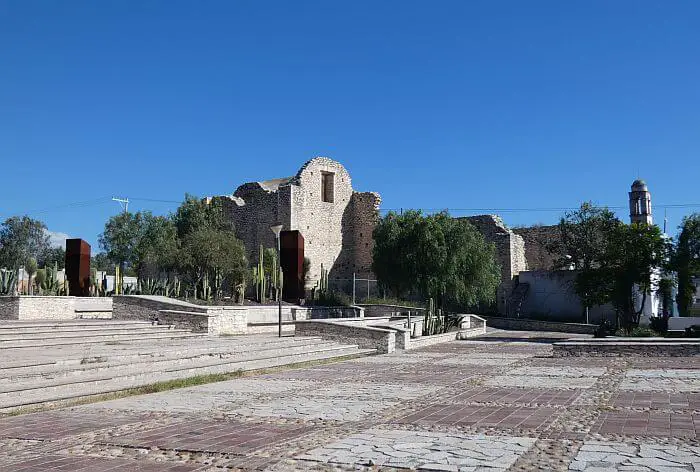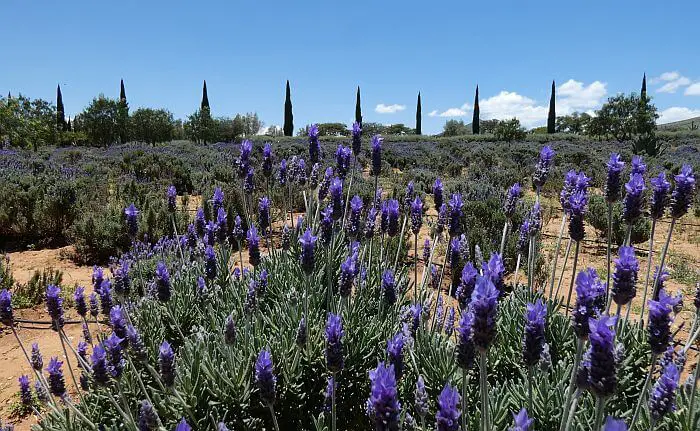Ghostly Quiet in Mineral de Pozos in Central Mexico
Story and photos by Tim Leffel
The ghost towns of Mexico are often filled with remnants of the country's colonial past, eerie places filled with crumbling stone buildings that endure through the centuries. A writer tramps through the fallen bricks and cacti in Mineral de Pozos, Guanajuato state.

As the sun was going down behind the mountains, there was something eerie going on. All I could hear was the creaking of an old metal windmill as I looked out over the cacti, agave, and shrubs. A little wind whistled past my ears, but there are no sounds of music, traffic, animals, or broadcasts. I’m starting to think this might be an evening where we sleep in silence—a rare luxury that’s a bonus of staying in a ghost town.
Normally when Americans hear “ghost town,” they think of abandoned wooden buildings with raised sidewalks in places where shootouts used to happen on the main street—the only street—in town. We envision raised sidewalks, saloons with swinging doors, and tumbleweeds blowing.
In Mexico, the pueblos fantasmas are more enduring because of the building materials used, but the towns were probably very similar in their heydays. They attracted rough men working in tough jobs like mining, those willing to go live in areas where nobody else wanted to go. Hard work leads to hard play on payday, of course, so they surely had their own saloons with swinging doors (enduring in Mexican cantinas still today), plus all the brothels, gambling halls and hooch sellers that spring up in mining towns. Here in the high desert of central Mexico where Mineral de Pozos is located, the occasional tumbleweed blows by as well.
This town went through more than one boom-and-bust cycle though, making it a rather unusual ghost town all around. The indigenous Chichimecas and other tribes lived here long before the Spanish came, in what is now Guanajuato state, and they didn’t make it easy for the Spaniards trying to move silver from one place to the other. A fort went up in 1576, called Palmar de Vega, the original name of the city. Setbacks from Spanish attempts to rule by force soon gave way to conquistador tactic number two: convert the heathens to Christianity. The Jesuits soon arrived and found that the place was more than a transit route. There was silver in the ground here too. They went to work extracting precious metal and the three conical ovens they built in 1595 are still standing today.

By the 1800s, the population of Mineral de Pozos was down to less than 8,000 and most of the buildings sat abandoned. The original mines were tapped out—or so many thought—and Mexico was fighting to push out the Spaniards and fight off the French as well. At the end of the century, however, President Porfirio Diaz was striving to industrialize the country and he poured money, infrastructure, and technology into the community to revive the mines and explore new ones. With ample jobs for anyone who wanted one, it didn’t take long for the population to increase by a factor of ten.
Once again though, the good times fizzled out in just a few decades. Civil war and the Mexican Revolution didn’t help, nor did the distressing frequency of mine shafts hitting underground water sources and flooding. A miner’s job is dangerous enough without the added risk of drowning in an underground tunnel.
When investors turned away and the workers said “Adios,” Mineral de Pozos spiraled into rapid decline. Looting and lawlessness drove out respectable businesses and by 1950, the population was down to less than 1,000 people, then just a few hundred.
The Rebirth of Mineral de Pozos
It took government recognition and investment to pull the town out of its first fall off a cliff economically and nearly a century later, the national government came to the rescue again. In 1982 they declared the city a “National Monuments Zone” and a few intrepid pioneers started moving in to take advantage of cheap real estate and a hopeful future. They got an even bigger boost in 2012 when it became one of the original Pueblos Magicos (Magic Towns) back when that was still a small list of special places in Mexico. Film and TV producers noticed, ad agencies and magazines did evocative photos shoots, and tourists started drifting in on weekends to stay at interesting small hotels opening up.
During the week, however, this is still a place so calm that it’s hard to believe it’s in Mexico. I’m not used to experiencing anything close to quiet in this country. As an expat here, I’ve learned to live with aural cacophony at all times of the day and night. Mexicans thrive on noise like it’s an energy source, something that gives them life and keeps them moving. If there’s a rare void of silence, something must jump in to fill it: a mariachi band, a booming stereo, barking roof dogs, sirens, whistles, an impromptu concert in the square, or a pop-up disco in a park. Cars with giant speakers on the roof blast out advertisements for the traveling circus in town or the candidate that deserves to win the next election for mayor.
“Hey, turn it down!” is not a sentence that seems to have a translation in Spanish because it would only elicit a puzzled cock of the head. If someone called the cops about a noisy party next door it would become the talk of the station for weeks. It’s a common belief among bar owners in Mexico that if they don’t blast the music at a volume that drowns out conversation, “Nobody will know we are open.”
So a ghost town like Mineral de Pozos in Guanajuato state has an additional appeal beyond seeing the sights. It’s a chance to go back in time in another way, to an age before big speakers and the electricity that powers them. To find a quiet place where you can be alone with your thoughts.
We spent our first night at a hotel that makes that even easier, an odd three-room affair called Mineral del Cielo. Built on the site of a former mining hacienda, the former administrative building is now a suite. There’s a custom-built stone labyrinth, a big free-standing stone event building, two reflecting pools, and two other casitas for sleeping. The well-planned xeriscape gardens meander through the grounds.

The views are impressive and the design is striking but, like Mineral de Pozos itself, the place feels rather devoid of life. If it’s fully occupied, there are six people plus a guest relations manager and security guard. It serves its purpose of offering a unique atmosphere with quiet and solitude though: we both had the best sleep we’ve managed in months. There are nights at home, enduring the barking roof dogs, when I wish I could return.
Walking With Ghosts and a Few Live Residents
The double boom-and-bust of this location makes it doubly attractive for visitors as well. Some former mining towns that declined 300 years ago in the peak of Spanish power are now just piles of rubble. In this location, however, the ruins in this area still retain whole walls and doorways from their original structures.
You can wander through the previous mining settlements and see former administrative buildings and churches. At Hacienda Santa Brigida de Morin, the grand hacienda building still stands strong and you can make out buildings used for worship, mining, or living.
Mineral de Pozos is still kind of a ghost town in a commercial sense if you arrive during the week like we did. On weekends it gets a fair number of day-trippers coming over on tours from popular San Miguel de Allende, but the rest of the time there’s just a trickle of visitors arriving by car, only a small portion of those spending the night. Just a smattering of locals sit in the grand plazas dotted around the center, built with Magic Town money from the government to support a slice of tourists they hope to entice over from popular San Miguel de Allende.

When we tried to visit the Cinco Señores mining ghost town on a Thursday, the gate was padlocked and there wasn’t a sign of life in any direction. No number to call, no hours posted, just an informational sign telling us this was one of the most popular tourist sites in the region. I kept waiting for that proverbial tumbleweed to blow down the road.
In its heyday, Hacienda Cinco Señores was a thriving center, its three mines cranking out a bit of gold and a lot of silver, some of it pure enough to go straight to the mint in Mexico City to produce coins. Now acres of buildings stand alone and lifeless, apart from the frequent reports of ghosts in the courtyards at night.

Fortunately, no high wall or locked gate keeps visitors out of the Angustias ghost town within walking distance down the hill. We had the whole abandoned town to ourselves, walking through wildflowers and succulents to see churches, a chapel, production facilities, and what was probably an owner’s estate.
It would be fascinating to pop back in time and see it bustling with hundreds of people, such a contrast with the peaceful stroll in the ruins it offers now, the only sounds being the occasional distant car or a braying donkey. In the jungles of Mexico the vines take over quickly, but in this dry climate it’s the cacti that slowly push through slowly over a century and assert their dominance.

While we explored Angustias, we could climb stairs now open to the sky and see the even larger Triangulo mining complex stretching out before us nearby. Hulking equipment still stood in place where it operated constantly before a mine shaft flooded and it all quickly came to a halt. The owners just walked away after that, choosing the early 1900s version of bankruptcy.
Driving around the area, we spotted lone buildings standing on a hill, their original purpose a mystery, as well as grand modern homes going up on the edge of town along a newly built road. Someone is clearly betting on a bright future. Will those still be standing in a hundred years? Will they be bustling with residents or filled with ghosts?
 When we pulled up to Hacienda Santa Brigida with its mines and famous 1595 “ovens,” a man appeared from somewhere and took our admission money of the equivalent of $3 each. That enabled us to explore a ghost town that took close to an hour to explore, with exposed mine shafts, production buildings, and impressive “magic arches” that would make for an ideal music video shoot.
When we pulled up to Hacienda Santa Brigida with its mines and famous 1595 “ovens,” a man appeared from somewhere and took our admission money of the equivalent of $3 each. That enabled us to explore a ghost town that took close to an hour to explore, with exposed mine shafts, production buildings, and impressive “magic arches” that would make for an ideal music video shoot.
While the big pit mine must have been an ugly mess with untold environmental woes in the 1600s, today it just looks like a big canyon, one that daring selfie-takers could slide into with one slip of the foot. The man who took our money told us to listen at the big shaft nearby, next to the original church. When we did, we could hear swarms of bees way down below.
The Second Comeback of Mineral de Pozos
We found plenty of signs of life in this new incarnation of Mineral de Pozos. Three breweries operate in the area, including the Vopper one in the Casa Diamante Hotel complex. It even has a spa where you can do more than get a massage and facial: two giant barrel tubs host guests wanting to soak in beer while sipping a beer.
We passed on that option but visited the nearby Mezcal Cuanax distillery for a tour and tasting. The company has to import the Espadin variety of maguey plant to make one version, but the others are based on varieties growing in the area’s fields. In our blind intro to their offerings, we tasted one intriguing mezcal that seemed softer and more floral than any I’ve tried before. It turns out that one of their mezcals is infused with lavender.

There’s no shortage of lavender in this area of Mexico and every winery seems to be growing enough to supply a perfume factory. (There area lot of happy bees in Guanajuato state.) There’s a dedicated lavender farm outside of Mineral de Pozos though that’s a great stop for a stroll among the flowers. After we finished touring around, we sampled a lavender cream popsicle and a lavender beer while sitting out in the warm sun.
Although the open restaurants in town aren’t numerous, especially on weekdays, we found a few good local spots and some fine dining options that are elevating the local scene. With a real coffee shop serving good expressos and local Tres Calderas beer on the menu at the rooftop deck of Rey de Pozos, the stop-offs for refreshment showed signs of a town on the comeback trail.
We spent our second night at Posadas de la Minas Hotel, a place built on the site of a restored building that was once in ruins. Travelers who walked by it two decades ago probably assumed it would stay abandoned. This one had good bones and a prime location, however, plus no worries about what kinds of toxins and mining sludge lie buried underground. The owners restored it to glory as a place to sleep and eat, but retained many of the ruined walls and arches for evocative outdoor dining and drinking areas.

We had dinner on one of those patios, sipping a Vopper beer, and wondered what this place will look like two decades in the future. Will the abandoned mining towns get a ticket gate and start charging more? Will those custom home projects start encroaching on them and elicit complaints about overdevelopment? Will the city pave the long dirt road to Hacienda Santa Brigida so they can attract big tour buses?
It's hard to predict the future when it comes to ghost towns, but in Mineral de Pozo's current state, we found a blissful place to spend a few quiet days and nights exploring.
IF YOU GO:
If you consult Wikipedia, which is often a bad idea, you’ll read that, “The houses here are abandoned, many in ruins and none with roofs.” Most buildings in the center do have roofs, as do a variety of nice hotels, restaurants, and shops selling handicrafts. Follow the article links for where we stayed, both places recommended. Mineral de Pozos is about an hour by car from San Miguel de Allende (you can book a day tour from there), less from Dolores Hidalgo. See more at the official Guanajuato State Tourism site.
Editor Tim Leffel is an award-winning travel writer and blogger who is based in Mexico. He is author of several books, including The World's Cheapest Destinations, Travel Writing 2.0, and A Better Life for Half the Price. See his long-running bargain travel blog here.
Related Features:
A Vintage Roadtrip: Butterflies, Blues and VW Buses - Lydia Carey
The Dreams of Man in Stone and Concrete - Tim Leffel
The Unveiling of Mezcal: Visiting Oaxaca's Artisanal Distilleries - Lydia Carey
The Fruit of Empire in the Banana Republics - Richard Arghiris
See other Mexico travel stories in the archives
Copyright © Perceptive Travel 2021. All rights reserved.
- Chasing Waterfalls in Portugal in All the Wrong Ways by Lydia Carey
- A Strange Garden With a Backstory: Ganna Walska's Lotusland by Sherry Shahan
- Experiencing Day of the Dead as an Expat Family in Mexico by Cassie Pearse
- Travel Book Reviews by William Caverlee
Books from the Author:

Buy A Better Life for Half the Price at your local bookstore, or get it online here:
Amazon US
Amazon Canada
Amazon UK
E-reader versions

Buy The World's Cheapest Destinations: 26 Countries Where Your Travel Money is Worth a Fortune at your local bookstore, or get it online here:
Amazon
Amazon Canada
Amazon UK
Kobo

Buy Make Your Travel Dollars Worth a Fortune: The Contrarian Traveler's Guide to Getting More for Less at your local bookstore, or get it online here:
Amazon
Kobo

